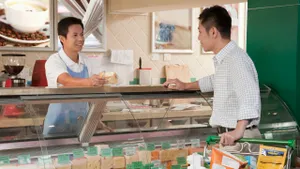Amazon unveils ‘curbside recyclable’ grocery delivery packaging
Insulated paper solution to be used for Amazon Fresh, Whole Foods perishables orders
November 17, 2021

While much of the attention on sustainable food packaging focuses on the point of purchase, Amazon has unveiled a solution for the point of delivery.
Stephenie Landry, vice president of Amazon Grocery, said in a blog post on Wednesday that perishables deliveries from Amazon Fresh and Whole Foods Market now will come in “curbside recyclable” insulated paper packaging.
“Rolling out just in time for Thanksgiving, Amazon’s new packaging is made from recycled paper and is curbside recyclable,” Landry wrote. “Whether customers are ordering turkey, green beans, or frosty pints of ice cream, chilled and frozen foods from Amazon Fresh and Whole Foods Market will arrive insulated in packaging that is easy and convenient for customers to recycle at home.”

Made from recycled paper, the paper packaging is convenient for customers to recycle at home because it’s 'curbside recyclable,' according to Amazon.
Seattle-based Amazon said its shift to all curbside-recyclable insulated packaging will cut back on material waste, replacing about 735,000 pounds of plastic film, 3.15 million pounds of natural cotton fiber and 15 million pounds of non-recyclable mixed plastic annually.
“The new packaging is also produced regionally in the U.S., enabling us to deliver it to Amazon Fresh grocery hubs, stores and Whole Foods Market locations with fewer miles traveled across the supply chain,” Landry noted.
The new grocery delivery packaging is part of Amazon’s overall sustainability efforts as well as The Climate Pledge, a commitment made by the company in 2019 to be net-zero carbon across its business by 2040, 10 years ahead of the Paris Agreement.
“We have long wanted to find a more sustainable solution for the plastic liners and bubble bags that are often used to insulate chilled and frozen items,” Joe Rake, senior program manager for customer packaging experience at Amazon, told Landry in a Q&A.
Key considerations in developing the new packaging included ensuring that the insulated material properly chilled the food inside and was compact, flexible, easily recyclable, inexpensive and scalable, according to Rake.

The curbside-recyclable insulated packaging will cut back on material waste, including plastic and cotton fiber.
“Once we started seeing consistent results in the lab, we moved to the pilot stage in 2020. We conducted pilots in multiple cities and under a variety of temperature scenarios,” he explained. “At the same time, as we slowly rolled this out, our food safety team conducted secret-shopper programs to validate the thermal effectiveness of the packaging. We also paid very close attention to customer feedback, along with employee feedback, on how to best pack orders using the new packaging.”
Amazon built on earlier progress made in grocery delivery packaging. In 2018, the company introduced frozen water bottles as an alternative to frozen gel packs to provide a grocery insulation solution that’s recyclable or reusable by customers. And in 2019, the e-tail giant began exploring options for the plastic liners and bubble-bag insulation, which led to the new solution of recycled paper tissue layering.
The goal is to send less material to landfills and more back into the circular economy loop, Rake pointed out. “As the leader of grocery delivery, we recognized an urgent need to find sustainable solutions that can eliminate hard-to-recycle materials,” he said, “and we are proud to be focused on scaling these solutions.”
About the Author
You May Also Like






